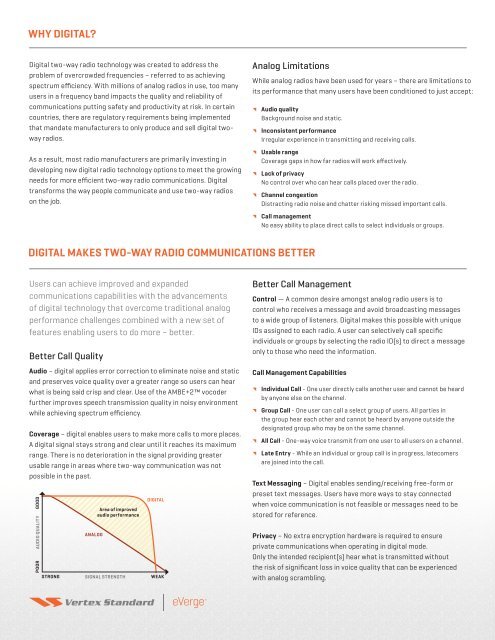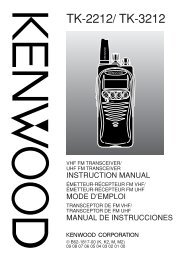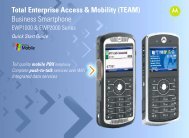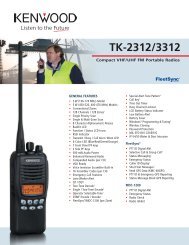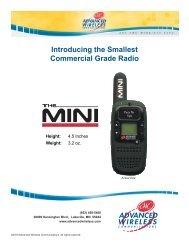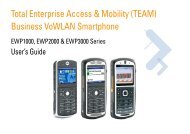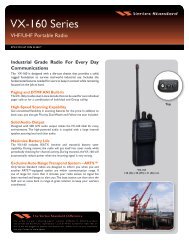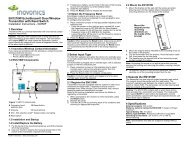Guide to Digital Mobile Radio - Vertex Standard
Guide to Digital Mobile Radio - Vertex Standard
Guide to Digital Mobile Radio - Vertex Standard
You also want an ePaper? Increase the reach of your titles
YUMPU automatically turns print PDFs into web optimized ePapers that Google loves.
WHY DIGITAL?<br />
<strong>Digital</strong> two-way radio technology was created <strong>to</strong> address the<br />
problem of overcrowded frequencies – referred <strong>to</strong> as achieving<br />
spectrum efficiency. With millions of analog radios in use, <strong>to</strong>o many<br />
users in a frequency band impacts the quality and reliability of<br />
communications putting safety and productivity at risk. In certain<br />
countries, there are regula<strong>to</strong>ry requirements being implemented<br />
that mandate manufacturers <strong>to</strong> only produce and sell digital twoway<br />
radios.<br />
As a result, most radio manufacturers are primarily investing in<br />
developing new digital radio technology options <strong>to</strong> meet the growing<br />
needs for more efficient two-way radio communications. <strong>Digital</strong><br />
transforms the way people communicate and use two-way radios<br />
on the job.<br />
Analog Limitations<br />
While analog radios have been used for years – there are limitations <strong>to</strong><br />
its performance that many users have been conditioned <strong>to</strong> just accept:<br />
^^<br />
^^<br />
Audio quality<br />
Background noise and static.<br />
Inconsistent performance<br />
Irregular experience in transmitting and receiving calls.<br />
^ ^ Usable range<br />
Coverage gaps in how far radios will work effectively.<br />
^^<br />
Lack of privacy<br />
No control over who can hear calls placed over the radio.<br />
^ ^ Channel congestion<br />
Distracting radio noise and chatter risking missed important calls.<br />
^ ^ Call management<br />
No easy ability <strong>to</strong> place direct calls <strong>to</strong> select individuals or groups.<br />
DIGITAL MAKES TWO-WAY RADIO COMMUNICATIONS BETTER<br />
Users can achieve improved and expanded<br />
communications capabilities with the advancements<br />
of digital technology that overcome traditional analog<br />
performance challenges combined with a new set of<br />
features enabling users <strong>to</strong> do more – better.<br />
Better Call Quality<br />
Audio – digital applies error correction <strong>to</strong> eliminate noise and static<br />
and preserves voice quality over a greater range so users can hear<br />
what is being said crisp and clear. Use of the AMBE+2 vocoder<br />
further improves speech transmission quality in noisy environment<br />
while achieving spectrum efficiency.<br />
Coverage – digital enables users <strong>to</strong> make more calls <strong>to</strong> more places.<br />
A digital signal stays strong and clear until it reaches its maximum<br />
range. There is no deterioration in the signal providing greater<br />
usable range in areas where two-way communication was not<br />
possible in the past.<br />
POOR AUDIO QUALITY GOOD<br />
STRONG<br />
ANALOG<br />
Area of improved<br />
audio performance<br />
SIGNAL STRENGTH<br />
DIGITAL<br />
WEAK<br />
Better Call Management<br />
Control — A common desire amongst analog radio users is <strong>to</strong><br />
control who receives a message and avoid broadcasting messages<br />
<strong>to</strong> a wide group of listeners. <strong>Digital</strong> makes this possible with unique<br />
IDs assigned <strong>to</strong> each radio. A user can selectively call specific<br />
individuals or groups by selecting the radio ID(s) <strong>to</strong> direct a message<br />
only <strong>to</strong> those who need the information.<br />
Call Management Capabilities<br />
^^<br />
^^<br />
^^<br />
^^<br />
Individual Call - One user directly calls another user and cannot be heard<br />
by anyone else on the channel.<br />
Group Call - One user can call a select group of users. All parties in<br />
the group hear each other and cannot be heard by anyone outside the<br />
designated group who may be on the same channel.<br />
All Call - One-way voice transmit from one user <strong>to</strong> all users on a channel.<br />
Late Entry - While an individual or group call is in progress, latecomers<br />
are joined in<strong>to</strong> the call.<br />
Text Messaging – <strong>Digital</strong> enables sending/receiving free-form or<br />
preset text messages. Users have more ways <strong>to</strong> stay connected<br />
when voice communication is not feasible or messages need <strong>to</strong> be<br />
s<strong>to</strong>red for reference.<br />
Privacy – No extra encryption hardware is required <strong>to</strong> ensure<br />
private communications when operating in digital mode.<br />
Only the intended recipient(s) hear what is transmitted without<br />
the risk of significant loss in voice quality that can be experienced<br />
with analog scrambling.


